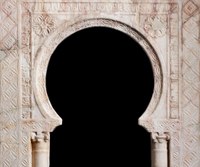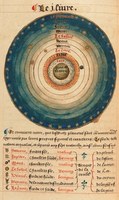Past Exhibitions
 RETHINKING ETRURIA
RETHINKING ETRURIA
April 23rd–July 20th 2025
Rethinking Etruria spotlighted newly excavated material from two Italian sites—the sanctuary of Poggio Colla and the Lattanzi tombs from Norchia—and how these discoveries, alongside novel digital approaches, have revealed intriguing new insights about the Etruscan people and their still enigmatic culture. The show featured some 50 objects from archaeological excavations as recent as 2024, many of which had never been displayed before, as well as 3D models, prints, and AI renderings that offer exciting new perspectives on these Etruscan sites. By combining archaeological finds and digital approaches, Rethinking Etruria shaped our vision of Etruscan society, amplifying the voices of its people and providing insights into their culture through their own words.
MADINAT AL-ZAHRA
The Radiant Capital of Islamic Spain
October 30th 2024–March 2nd 2025
Madinat al-Zahra: The Radiant Capital of Islamic Spain, presented the little-told story of the Islamic kingdoms of Europe. The exhibition explored how the Umayyad family, ruling from their capital Madinat al-Zahra (936–1013 CE) in Cordoba, Spain, transformed the Iberian Peninsula into a bustling hub for scholars, artists, and diplomats from Baghdad to Byzantium. The Umayyads desire to express their power, or al-mulk, led them to forge a thriving cosmopolitan society with international tastes in luxury goods, unique architectural styles that blended Islamic and Classical traditions, and a scientific curiosity of the universe. Madinat al-Zahra presented over 150 objects from the caliphal capital that showcase how the Umayyads fashioned the city into one of the gleaming jewels of the Medieval world.
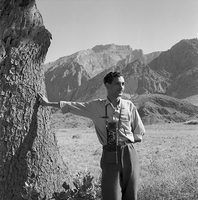 THROUGH THE LENS
THROUGH THE LENS
Latif Al Ani's Visions of Ancient Iraq
November 8, 2023–February 25, 2024
Featuring fifty evocative photographs by Latif Al Ani (1932–2021), a pioneer of Iraqi photography, the exhibition invited viewers to follow his unique perspective of Iraq’s golden age of modernism (1958–1980), which was driven by the oil industry. Al Ani’s photographs include some of the first aerial perspectives of both modern and ancient cities in Iraq, and document European visitors’ fascination with the monuments of Mesopotamia. His gaze reveals the appropriation and reimagining of Iraq’s past through photographs of sites excavated and interpreted by Western archaeologists in the 1850s, which can be seen in the lithographs and engravings documenting the early British excavations of Nineveh and Nimrud featured in this exhibition.
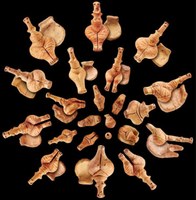 RITUAL AND MEMORY
RITUAL AND MEMORY
The Ancient Balkans and Beyond
September 21, 2022 – February 19, 2023
Featuring loans from eleven countries, Ritual and Memory presented a range of exquisite artifacts—not only figurines but also eating and drinking vessels, jewelry, sculptures, swords, axes, altars, and more — from a region that stretches from the Balkan Mountains to the Carpathian Basin. Beginning in the Neolithic Period (about 8,000 years ago) and extending through the Iron Age (about 2,500 years ago), this show presented seldom-exhibited ritual objects used by men and women, warriors and wives, kings and farmers, in celebrations and in funerals. The exhibition invites visitors to consider beliefs, ritual practices, and community organization in different ancient cultures, and what such artifacts reveal about the connections between various groups in the region in times of both war and peace.
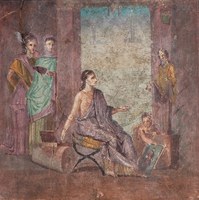 POMPEII IN COLOR
POMPEII IN COLOR
The Life of Roman Painting
January 26, 2022 – May 29, 2022
Pompeii in Color: The Life of Roman Painting presented thirty-five frescoes from the National Archaeological Museum of Naples. Among these important works—all originally from Roman homes—are paintings representing dynamic mythological scenes, inviting landscapes, sumptuous still lifes, astonishing trompe-l’oeil, captivating portraits, and energetic genre scenes. This exhibition presented an exciting opportunity to learn about ancient painting, the tastes and values of the Romans who lived with these works, as well as the techniques used by the artists who created them. Seldom exhibited outside Italy, these remarkably well-preserved frescoes invite us to see beyond the ashes of the tragic city, and instead experience the vibrant world of the ancient Roman home as the Pompeians themselves knew it.
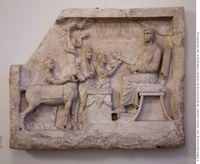 THE EMPIRE'S PHYSICIAN
THE EMPIRE'S PHYSICIAN
Prosperity, Plague, and Healing in Ancient Rome
February 2021 – (online)
Presenting the life of the influential Roman doctor Galen (129–ca. 216 CE), this richly-illustrated, interactive online exhibition contextualizes the doctor's biography within the ancient medical landscape as well as within his broader historical situation. A learned, accomplished physician, he treated a range of patients—men and women, adults and children, peasants and emperors—afflicted with a variety of conditions. Additionally, he described the several crises of his day, including the Great Fire and the Antonine Plague. Galen's prolific writings provide not only an account of the ancient healing arts and attendant debates, but also a broader sense of life in the Roman Empire.
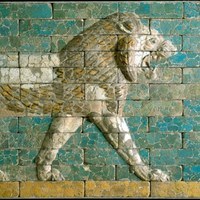 A WONDER TO BEHOLD
A WONDER TO BEHOLD
Craftsmanship and the Creation of Babylon's Ishtar Gate
November 6, 2019 – May 14, 2020
On the banks of the Euphrates River, sixty miles from Baghdad in modern-day Iraq, lies the ancient city of Babylon. At its height, Babylon was the cosmopolitan center of a vast ancient Middle Eastern empire. The city was carefully built and richly decorated to emphasize its political and religious importance. One of the city's most spectacular monuments was the Ishtar Gate and its affiliated Processional Way—a double gate and long causeway featuring hundreds of colorful, life-size beasts. Linked to the gods, these creatures provided a divinely protected and ritualized entryway into the inner city of Babylon.
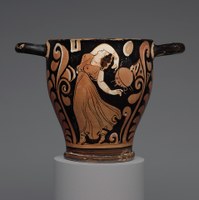 HYMN TO APOLLO
HYMN TO APOLLO
The Ancient World and the Ballets Russes
March 6, 2019 – June 2, 2019
What can we know about ancient dance? Why did European avant-garde artists look to the past at the beginning of the twentieth century? This exhibition presented images of dance from antiquity in art and culture, as well as the influence of this history on modernist reinventions of the Ballets Russes (1909–1929). A Paris-based company led by Sergei Diaghilev, the Ballets Russes revolutionized ballet by bringing together some of the generation's most exciting choreographers, dancers, artists, and composers. Presenting a new, modern vision of dance that frequently drew inspiration from the ancient world, they influenced a generation of contemporaries across the arts.
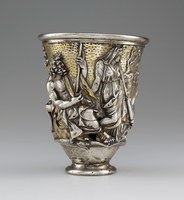 DEVOTION AND DECADENCE
DEVOTION AND DECADENCE
The Berthouville Treasure and Roman Luxury from the Bibliothèque nationale de France
October 17, 2018 – January 6, 2019
Discovered by chance by a farmer in rural Normandy while plowing his field, the Berthouville Treasure is the largest and best-preserved hoard of silver from the ancient world. Gilt-silver statuettes and vessels—about ninety silver pieces weighing over fifty pounds in total—had been buried in a brick-lined cist during antiquity. Located in an area of ancient pilgrimage, assembly, and spectacle, the site was a Gallo-Roman religious sanctuary devoted to Mercury Canetonensis.
 ROMANCE AND REASON
ROMANCE AND REASON
Islamic Transformations of the Classical Past
February 14, 2018 – May 13, 2018
The story of antiquity reads as an endless cycle of expansion, conflict, and conquest as different groups and leaders sought to expand their power, enhance their resources, and understand the universe. Despite the divisions that existed between people and nations, the exchange of images and ideas was boundless. Beginning in the eighth century CE, images from Classical antiquity were incorporated into the Islamic world and contributed to the shaping of their universe.
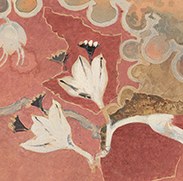 RESTORING THE MINOANS
RESTORING THE MINOANS
Elizabeth Price and Sir Arthur Evans
October 5, 2017 – January 7, 2018
The British archaeologist Sir Arthur Evans (1851-1941) fundamentally shaped our understanding of the Minoan world. He excavated the so-called Palace of Minos on the island of Crete and came to believe he had found the remnants of Daidalos's mythological labyrinth, home to the Minotaur. As the first person to recognize the distinctiveness of the Minoans, his contribution to archaeology cannot be underestimated, yet his bold restoration of the site at Knossos confronts viewers with images of an ancient world that appear distinctively modern.
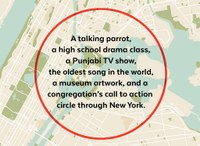 ...circle through New York
...circle through New York
March 1 – August 31, 2017
A talking parrot, a high school drama class, a Punjabi TV show, the oldest song in the world, a museum artwork, and a congregation's call to action circle through New York. Artists Lenka Clayton and Jon Rubin have drawn an imaginary circle through New York and invited six different venues along that circle's path to participate in a collaborative art project.
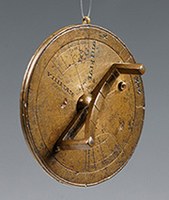 TIME AND COSMOS IN GRECO-ROMAN ANTIQUITY
TIME AND COSMOS IN GRECO-ROMAN ANTIQUITY
October 19, 2016 – April 23, 2017
The Ancient Greeks and Romans contributed more than any other past civilization to the rise of time's dominion over individual and public life. Adapting ideas from Egypt and Babylonia, they divided the day into hours, and invented sophisticated instruments and devices to mark their passage. This exhibition aims to explore the ways that time was organized and kept track of in the Greco-Roman world, and how it was conceived in relation to the Cosmos.
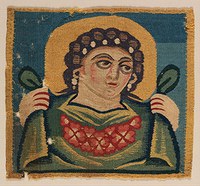 DESIGNING IDENTITY
DESIGNING IDENTITY
The Power of Textiles in Late Antiquity
February 25 – May 22, 2016
Designing Identity: The Power of Textiles in Late Antiquity, offered intimate glimpses into the lives of those who commissioned and used textiles and more sweeping views across Late Antique society (roughly third to seventh century CE). The exhibition brought together over fifty textiles of diverse materials, techniques, and motifs to explore how clothing and cloth furnishings expressed ideals of self, society, and culture.
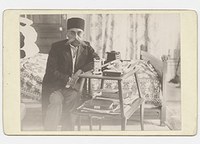 THE EYE OF THE SHAH
THE EYE OF THE SHAH
Qajar Court Photography and the Persian Past
October 22, 2015 – January 17, 2016
The Eye of the Shah: Qajar Court Photography and the Persian Past presented some 200 photographic prints, a number of vintage photographic albums, and memorabilia that utilized formal portraiture of the shah. The exhibition shows how photographers—many of them engaged by Naser al-Din Shah Qajar (r. 1848-1896), the longest reigning Shah of the Qajar Dynasty (1785-1925)— ultimately created a portrait of the country's ancient and recent past. Most of the photographs in the exhibition had never been publicly displayed.
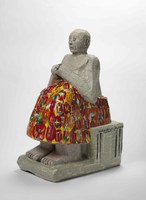 FROM ANCIENT TO MODERN
FROM ANCIENT TO MODERN
Archaeology and Aesthetics
February 12, 2015 – June 7, 2015
From Ancient to Modern: Archaeology and Aesthetics displayed a series of spectacular early Mesopotamian objects alongside rich documentation, opening a window onto the ways in which archaeological finds of the 1920s and 1930s were transformed from artifacts into works of art. This process raises fundamental and critical questions: What biographies were initially given to these objects by their discoverers? How were these objects filtered through the eyes and voice of the press before they were seen by the public? How were the objects' biographies affected by or reflective of the tastes of the time? How were the items presented in museums and received by artists of the period? And finally, how do they continue to influence artistic practice today?
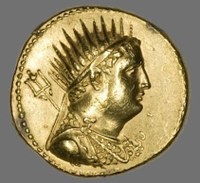 WHEN THE GREEKS RULED EGYPT
WHEN THE GREEKS RULED EGYPT
From Alexander the Great to Cleopatra
October 8, 2014 – January 4, 2015
When the Greeks Ruled Egypt: From Alexander the Great to Cleopatraexamined the interactions between Greek and Egyptian cultures during the nearly 300-year period when Egypt was under Greek rule. With some 150 objects, the exhibition revealed the many and diverse ways in which cultural tropes were strategically used by Egypt’s Ptolemaic rulers as a means of asserting power and provoking loyalty among the conquered population. In the process, it also revealed the intense familial intrigue and jockeying for position that characterized the Ptolemies as they sought to maintain their position.
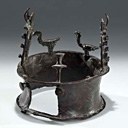 MASTERS OF FIRE
MASTERS OF FIRE
Copper Age Art from Israel
February 13, 2014 – June 8, 2014
In 1961 Israeli archaeologists discovered over 400 copper objects at Naḥal Mishmar in what was to become known as the Cave of the Treasure. These copper objects were so spectacular that they define an era in Southern Levantine history now known as the Copper Age (4500–3600 bce). Masters of Fire: Copper Age Art from Israel explores this “metallurgical revolution” and the accompanying social and cultural changes through a series of unprecedented loans from one of the greatest hoards of antiquity. It also presents the first comprehensive U.S. exhibition of other archaeological discoveries from this period—anthropomorphic and zoomorphic ossuaries, technically elaborate wool and linen textiles, and exceptionally rendered figurines. When viewed together, these objects reveal a dynamic world whose technological advancements revolutionized art and society.
MEASURING AND MAPPING SPACE
Geographic Knowledge in Greco-Roman Antiquity
October 4, 2013 – January 5, 2014
Measuring and Mapping Space explored the ways in which ancient Greek and Roman societies understood, perceived, and visualized both the known and the unknown areas of their world. It brought together more than forty objects, combining ancient artifacts with Medieval and Renaissance manuscripts and printed books that draw upon ancient geographic treatises. Together, they provided a fascinating overview of Greco-Roman theories of the shape and size of the Earth, ancient methods of surveying and measuring land, and the ways in which geography was used in Roman political propaganda. A specially designed multimedia display examined the increasing importance of modern technologies in mapping the ancient world.
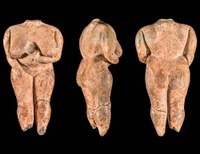 TEMPLE AND TOMB
TEMPLE AND TOMB
Prehistoric Malta, 3600-2500 BCE
March 21 – July 7, 2013
Located between southern Italy and the northern coast of Africa, the Maltese archipelago was home to an astonishing and artistically rich prehistoric culture. During the later Temple Period (ca. 3600–2500 bce), the early Maltese constructed extraordinary megalithic complexes to house cultic and funerary rituals, and produced an outstanding range of aesthetically refined representations of the human form.
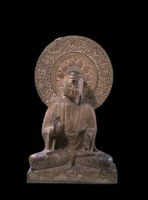 ECHOES OF THE PAST
ECHOES OF THE PAST
The Buddhist Cave Temples of Xiangtangshan
September 11, 2012 – January 6, 2013
Echoes of the Past unites a group of imposing sculptures from the Northern Qi period (550-577 CE) Buddhist cave temple complex at Xiangtangshan in northern China with a full-scale, digital, 3-D reconstruction of the interior of one of the site’s impressive caves. This innovative installation provides an unprecedented insight into the original setting for these remarkable sculptures by marrying twenty-first-century digital techniques and ancient objects. The sculptures are extraordinarily accomplished.
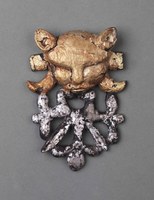 NOMADS AND NETWORKS
NOMADS AND NETWORKS
The Ancient Art and Culture of Kazakhstan
March 7 – June 3, 2012
Nomads and Networks is the first U.S. exhibition to provide a comprehensive overview of the fascinating nomadic culture of the peoples of eastern Kazakhstan’s Altai and Tianshan regions from roughly the eighth to first centuries bce. With over 250 objects on loan from Kazakhstan’s four national museums, the exhibition provides a compelling portrait that challenges the traditional view of these nomadic societies as less developed than sedentary ones.
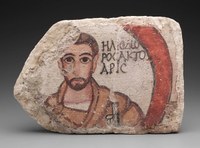 EDGE OF EMPIRES
EDGE OF EMPIRES
Pagans, Jews, and Christians at Roman Dura-Europos
September 23, 2011 – January 8, 2012
This exhibition vividly illustrated the international, pluralistic character of Dura-Europos, a city strategically located high above the Euphrates River, between Syria and Mesopotamia. The exhibition focused on its final phase, in the third century CE, when Dura-Europos served as an important Roman stronghold on the empire’s eastern edge. Many of the objects included demonstrate the coexistence of multiple religions—including polytheistic cults, Judaism, and Christianity—the great variety of languages employed by its population, and its role as an international military garrison.
 NUBIA
NUBIA
Ancient Kingdoms of Africa
March 11 – June 12, 2011
This exhibition featured over 120 objects illustrating the remarkable and distinctive aesthetics of Nubian art. The exhibition traced Nubia’s rich culture, which flourished in present day Sudan and southern Egypt, from its earliest kingdoms (3200–3000 BC) to the Kushite period (900–400 BC) during which Nubians rose to conquer Egypt and fought against the Assyrian empire.
 BEFORE PYTHAGORAS
BEFORE PYTHAGORAS
The Culture of Old Babylonian Mathematics
November 12, 2010 – January 23, 2011
This exhibition is the first to explore the world of Old Babylonian mathematics through cuneiform tablets covering the full spectrum of mathematical activity, from arithmetical tables to sophisticated work on number theory and algebra.
 THE LOST WORLD OF OLD EUROPE
THE LOST WORLD OF OLD EUROPE
The Danube Valley, 5000 - 3500 BC
November 11, 2009 – April 25, 2010
In 4500 BC, before the invention of writing and before the first cities of Mesopotamia and Egypt were established, Old Europe was among the most sophisticated and technologically advanced regions in the world. This exhibition presented extraordinary finds from the three countries with the richest Old European archaeological heritage—Bulgaria, the Republic of Moldova, and Romania.
 WINE, WORSHIP AND SACRIFICE
WINE, WORSHIP AND SACRIFICE
The Golden Graves of Ancient Vani
March 12 – June 1, 2008
Spectacular finds from two sanctuaries and four tombs illustrate that ancient Colchis was at the crossroads for many different peoples from the early fifth to the first centuries B.C.
